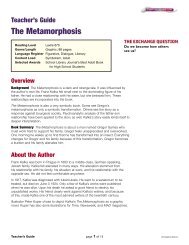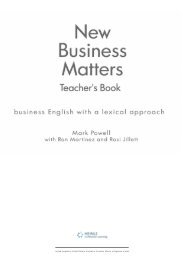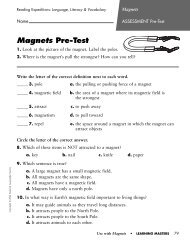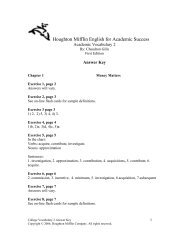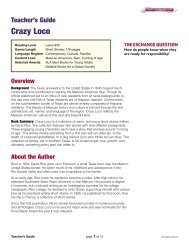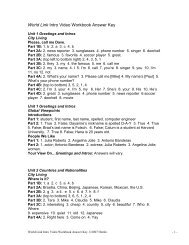English for Cabin Crew Trainer's Guide - Heinle
English for Cabin Crew Trainer's Guide - Heinle
English for Cabin Crew Trainer's Guide - Heinle
Create successful ePaper yourself
Turn your PDF publications into a flip-book with our unique Google optimized e-Paper software.
UNIT<br />
3 Case study<br />
LEAD IN Speaking<br />
Write, Flying with children on the board. Ask students what they<br />
think this refers to. Ask, What are the good things and bad things<br />
about having kids on board? What do you do to deal with any<br />
problems?<br />
EXERCISE 1 Reading<br />
Give students time to read the questions and check harsh (too strict or<br />
severe). Then ask students to read the text and make notes. Let students<br />
discuss the answers in pairs be<strong>for</strong>e discussing in open class.<br />
Answers<br />
1 children kicking the backs of seats; families talking loudly and passing<br />
things backwards and <strong>for</strong>wards; babies crying loudly<br />
2 Some passengers want parents to control children more, some suggest<br />
‘family-only’ zones on board. <strong>Cabin</strong> crew can ask parents to control<br />
children. Airlines sometimes provide cards / colouring books on the<br />
aircraft, and tables / chairs / toys at the departure gate.<br />
Vocabulary in context<br />
Write the following defi nitions on the board and ask students to match<br />
them to synonyms in the text: say they are at fault (blame); prepared<br />
to allow bad behaviour (permissive); small with little space to move<br />
(cramped); crazy (insane); out of control (unruly).<br />
EXERCISE 2 Speaking<br />
The aim here is to get students talking about their personal experiences.<br />
Give students time to read through the questions and think of responses.<br />
Ask them to discuss their responses in pairs or small groups. After a few<br />
minutes, get one student from each pair or group to briefl y summarize<br />
the main points of their discussion.<br />
Pre-teaching vocabulary<br />
Check the following key phrases: fl urry of activity (a lot of things<br />
happening at once); dealing with queries (answering questions); speed<br />
is of the essence (it is important to be quick); interact with passengers<br />
(meet and talk to passengers); nudging and poking (getting someone’s<br />
attention by putting your elbow or fi nger into their side); giggling<br />
(laughing like a small child).<br />
EXERCISE 3 and 4 Listening<br />
Give students time to read the situation and questions in exercise 3. Play<br />
the recording. Students listen, take notes, then discuss their answers in<br />
pairs. Get feedback in open class at the end.<br />
Follow the same procedure <strong>for</strong> exercise 4.<br />
Answers<br />
1 getting the drinks trolleys ready <strong>for</strong> the fi rst service; dealing with<br />
passengers’ queries<br />
2 The biggest difference is the need <strong>for</strong> speed on short-haul fl ights.<br />
Shon preferred long-haul because of the exotic destinations and,<br />
above all, the chance to interact with passengers.<br />
3 During take-off an elderly man held on to her foot without realizing it.<br />
(Students’ own ideas <strong>for</strong> what else she could have done)<br />
CD1 Track 3.9<br />
1 After take-off what were your main duties?<br />
S: Once the aircraft is in the air and the seatbelt signs go off, fl ight attendants<br />
are usually very, very busy. We are jumping out of our seats and getting the<br />
drinks trolleys ready <strong>for</strong> that fi rst service and there’s quite a fl urry of activity<br />
there because obviously the galleys are quite small and trolleys are coming out<br />
and the preparation will take about 10 to 15 minutes. In between all of that<br />
you're dealing with passenger queries. You know, somebody will be ringing the<br />
bell because as soon as they're airborne and the seatbelt signs go off, they<br />
want their questions answered, or they might feel cold or they might have a<br />
connection problem that they want to know about, so just after that take-off<br />
it can be quite intense <strong>for</strong> the cabin crew, setting the trolleys up and dealing<br />
with general passenger queries.<br />
2 Is there a big difference after take-off on short-haul and long-haul fl ights?<br />
S: The only difference between short-haul and long-haul fl ights in terms of the<br />
duties that fl ight attendants have is the speed I think because on a short-haul<br />
fl ight speed is of the essence so fl ight attendants have to work very, very fast<br />
to get those drinks trolleys or whichever service they are starting with, out,<br />
whereas on a long-haul fl ight there is not that time that you are racing against,<br />
so I think speed is probably the only thing that I can think of that is a real<br />
difference between short-haul and long-haul. I preferred the long-haul fl ights.<br />
It was always exciting anyway to know that you were going to Kuala Lumpur or<br />
Tokyo, but on top of that the long-haul fl ights <strong>for</strong> me were great because you<br />
had a chance to really interact with the passengers on board. You weren’t just<br />
having them <strong>for</strong> 30 minutes, which was the short-haul option and throughout<br />
a 12- or 14-hour fl ight you could really get to know some people well and do a<br />
really great job looking after them, so I particularly like the long-haul.<br />
3 Did you have any strange experiences after take-off?<br />
S: I remember once when I fi rst started fl ying, I was only about 20 and I was<br />
on a charter fl ight out of Birmingham and as we rumbled down the runway a<br />
lovely old couple sat in front of me at the door exit and as we took off this<br />
man sitting opposite me suddenly grabbed my foot and he held onto it <strong>for</strong><br />
at least fi ve minutes and I couldn’t move and I was nudging and poking my<br />
colleague and we were giggling quietly and only when the aircraft levelled out<br />
I was able to shake my foot at the passenger who was still holding it and he<br />
looked, he was so embarrassed, and he hadn’t realized how frightened he was<br />
and had grabbed my foot, and I couldn’t move, I couldn’t get up to help set<br />
up the drinks trolleys or do anything because he was holding onto my foot.<br />
So, that was quite funny and I’ve never <strong>for</strong>gotten it.<br />
EXERCISE 5 Speaking<br />
Ask students to work in pairs or groups of three/four to discuss the<br />
questions. Get feedback in open class and encourage students with<br />
interesting ideas to share with the class.<br />
ROUND UP<br />
Revise useful phrases from the unit by writing the following<br />
situations on the board and asking students to recall phrases<br />
that could be used in each situation:<br />
Tell passengers ...<br />
... you’re busy.<br />
... they can stand up.<br />
... you’re coming with the food trolley.<br />
... you’re there to help.<br />
... there is nothing to worry about.<br />
Ask students to work in pairs to write all the words and phrases<br />
they know, or to search the unit to fi nd words and phrases to<br />
write.<br />
15



